Tags
Brown Hare, Bugle, Common Comfrey, cow parsley, Creeping Buttercup, Dandelion clock, field maple, garlic mustard, Greater Stitchwort, ground-ivy, Hawthorn, Hedgerow Crane's-bill, Herb-Robert, Meadow Buttercup, orange-tip butterfly, red campion, rowan, Suffolk, trees, Tufted Forget-me-not, wild flowers, Wood Avens
This post will be featuring the wild life photographs I have taken away from home, either on short walks to the postbox for example, or when I have stopped the car having seen something special.
The Cow Parsley has been spectacular this year and especially so on the lane I drive down on my way to Norwich each day via Bungay. I was glad I took the following photos a couple of weeks ago as the road is now closed for road works and I hate to think what has happened to all these lovely flowers.
The Red Campion has never been better in all the time we have lived here too.
Male and female flowers are borne on separate plants.
This plant is a member of the Pink family and is a shade lover. It shines luminously in the twilight. Its stems are very weak and need the support of other plants to gain any height. The stems snap easily too, and according to the ancient ‘doctrine of signatures’ this means that the plant was thought to be able to help heal broken bones. The Greek words for whole ‘holos’ and bone ‘osteon’ are incorporated in the botanical name. The common name of Stitchwort refers not to mending but to another kind of stitch – the horrible pain in the side and similar ailments. A preparation of stitchwort and acorns taken in wine was a standard remedy. Stitchwort was regarded, at one time, along with White Campion and Field Poppy, as a ‘thunder flower’ – the picking of which provoked thunder and lightening.
Herb-Robert has orange pollen.
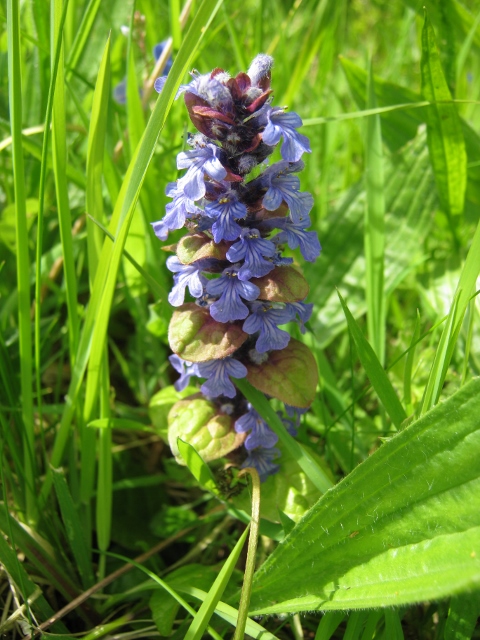
Bugle (Ajuga reptans) seems to be growing everywhere this year too. I don’t remember seeing any at all last year.
Bugle was thought of as a cure-all by medieval herbalists. It healed all kinds of wounds, thrusts and stabs, as well as ulcers and broken bones. It was also highly recommended for delirium tremens brought on by too much alcohol. It has been called one of the mildest and best narcotics in the world. The Latin name Ajuga and the common name Bugle appear to be corruptions of one or more of the plants earlier names of ‘abuga’, ‘abija’ and ‘bugula’.
This is the only British member of the cabbage family to smell very strongly of garlic. The smell of the small white flowers isn’t particularly pleasant but it attracts midges and hoverflies. The plant is self-pollinating. In June the pale green caterpillars of the Orange-tip butterfly can be seen feeding on the long green seed pods from which they are almost indistinguishable.
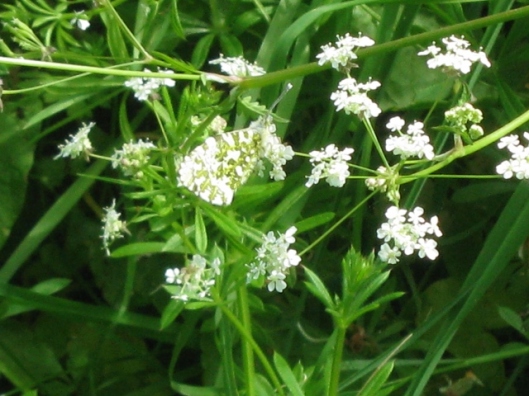
This is a photo of an Orange-tip butterfly feeding on the nectar from Cow Parsley. The camouflage is very good!
This plant spreads very quickly with long-rooted runners.
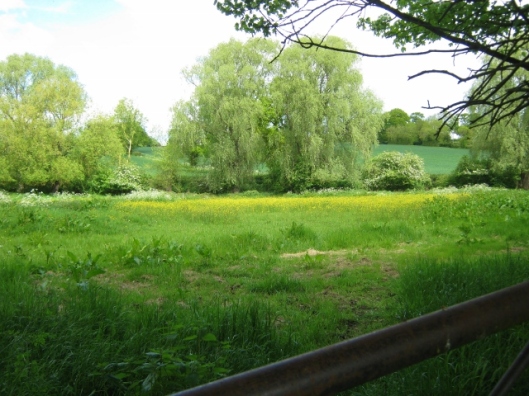
This is one of the fields next to the lane I drive down every day. It has a lot of buttercups in it (probably Meadow Buttercup (Ranunculus acris) )
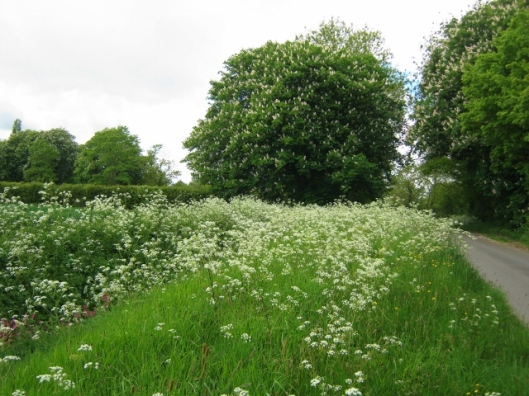
This shows the mass of Cow Parsley on the verge of the lane with two grand-looking Horse-chestnut trees (Aesculus hippocastanum) on the corner.
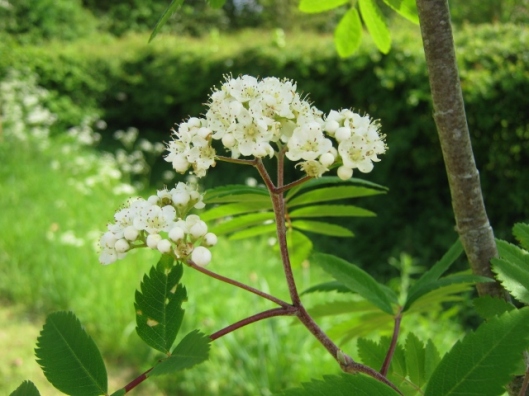
Rowan or Mountain Ash (Sorbus aucuparia). This is a photo I forgot to include in Part 1 as this is a tree in our garden.
Lastly, I include a couple of photos (not good) of a young Hare, or Leveret (as young Hares are called) that I saw in our garden yesterday. It was very curious, investigating everything. It kept on the move all the time, which made photographing it very difficult, suddenly racing off in one direction only to come racing back again next minute. It appeared to run for the joy of running!
Thank-you for visiting!



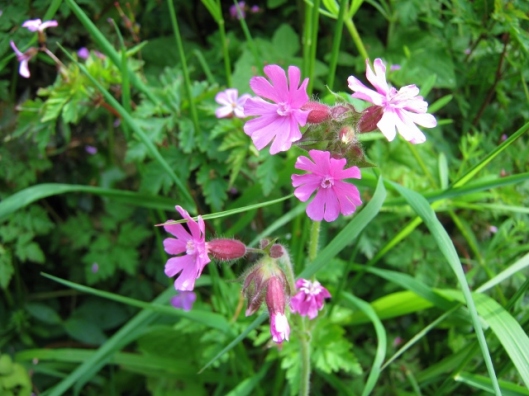
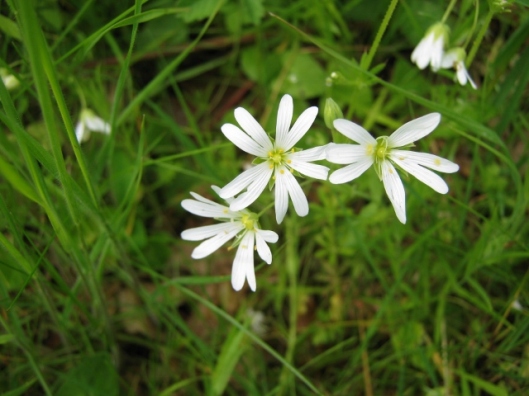
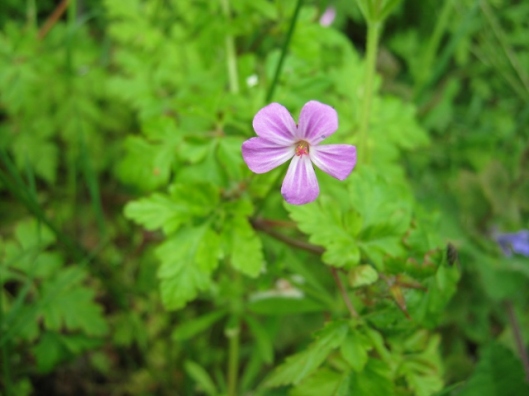


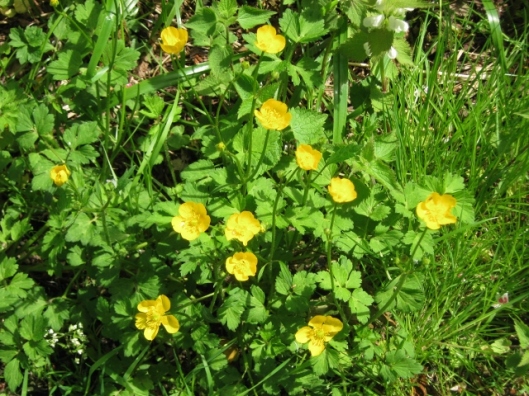

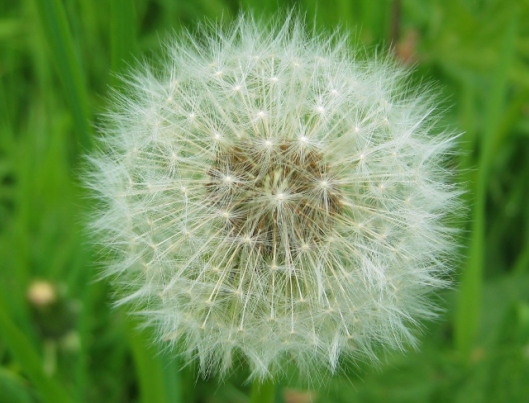

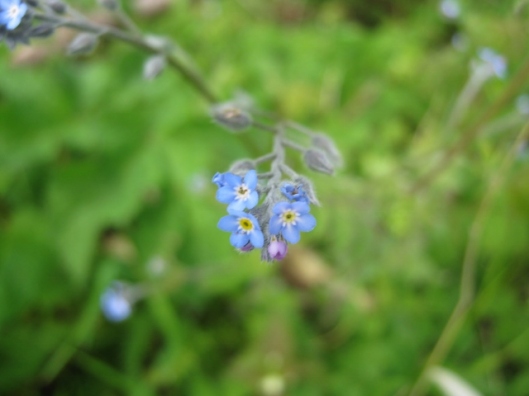
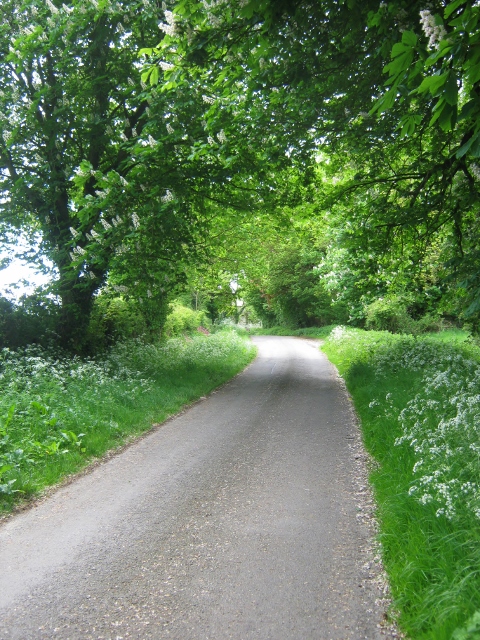
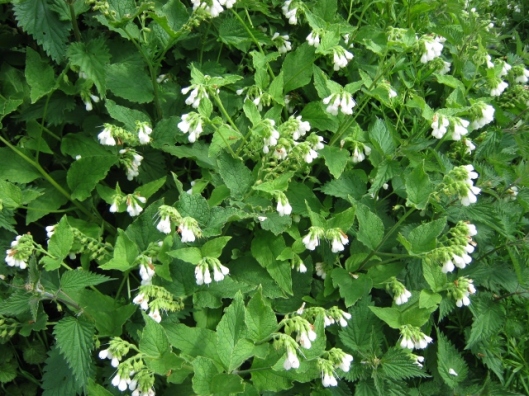




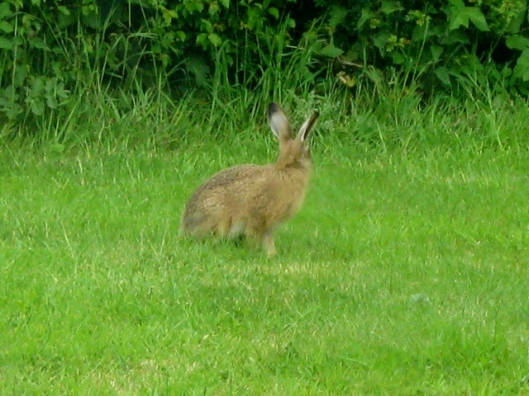

Long may that hare live to run joyfully! Your lane is charming, and the cow parsley beautiful! We used to have three Washington hawthorn trees, with those needle-like thorns. My brother got stuck so many times while mowing the lawn, he had them removed. The mockingbirds liked them, though.
LikeLiked by 1 person
Thank-you Lisa. Hawthorn is very spiny but is such a good hedging plant that there is always plenty of Hawthorn blossom to see in the spring here. Birds do like them because they provide good shelter and berries in the autumn. My husband often gets tangled up in the plants and bushes when mowing and I often find he’s chopped bits off plants that have got in his way. My father was the same. I think men go off into a dream when they mow the grass and forget to look where they’re going!
LikeLike
I adore hares, how lovely to have one visit you. Thanks for such a lovely post, gorgeous photos and an orange tip butterfly!
LikeLiked by 1 person
Thank-you Chiara! There are still quite a few Orange-tips about. Normally by the end of May they have disappeared but not this year. I was so pleased to see the hare in the garden – they don’t visit very often.
LikeLike
Beautiful photos, Clare! Your countryside looks so lovely. A nice shot of the hare as well!
LikeLiked by 1 person
Thank-you Lavinia! I love to see hares and this was such a young one and was so exuberant!
LikeLike
The English countryside is very pretty this time of year, it must make all the driving you have to do more bearable. Your knowledge of the flowers and plants is also very impressive, I wish that I had the patience to learn more about the local plants here.
LikeLiked by 3 people
Thank-you Jerry. I often think while I’m driving that my commute is so much nicer than most other peoples’. I drive through countryside and small villages and its only for the last couple of miles that we drive on a main road into the city. I know quite a few of the plants but still have to look up and research some for each post I write. I can never remember the botanical names of them all either. I don’t have the patience to learn the difference between all the wading birds we have!
LikeLike
The leveret has entirely the right response to your gorgeous countryside.
LikeLiked by 3 people
Yes it did seem to be enjoying itself!
LikeLiked by 1 person
I love all the little flowers!. We had a groundswell of Queen Anne’s Lace (daucum carota) this year, similar to your Cow Parsley. I hope that your life has sweetness like these plants.
LikeLiked by 1 person
Thank-you Aggie – what a lovely thing to say! We get Queen Anne’s Lace/Wild Carrot here but it flowers later in the year. I will see whether we get lots of that too.
LikeLiked by 1 person
Lovely and very uplifting Clare! Who needs a cultivated garden when there are so many beautiful wildflowers to see. Great shots of the young hare too, they are so speedy and hard to photograph.
LikeLiked by 1 person
Thank-you Julie. Yes, the hare wouldn’t keep still for more than a few seconds and these pictures were the best of a lot of very blurred photos. I am sure we’d be lost without a garden despite the frustrations when things won’t grow or will grow, but in the wrong place!
LikeLiked by 1 person
I could walk forever on that beautiful lane, Clare. Thanks for sharing your wonderful photos!
LikeLiked by 1 person
Thank-you Jill! I only meant to stop for a couple of minutes as I was on my way to the city to collect my daughter. I found myself wandering much further than I meant as I got distracted and then had to hurry.
LikeLiked by 1 person
I can certainly see why, Clare. 🙂
LikeLiked by 1 person
Isn’t the spring lovely?
LikeLiked by 1 person
Yes it is! Thank-you 🙂
LikeLiked by 1 person
bunny!!!
LikeLiked by 1 person
Haha! Yes! 🙂
LikeLiked by 1 person
The sheer lushness and exuberant abundance of the fields and roadside with it’s flowers, epitomizes what one dreams of in an idyllic Spring! How stunningly lovely it all looks~ All I imagine doing is either sitting in a green field listening to the birds and cloud watching or walking for miles and drinking in the sheer headiness of it all. Wonderful photos . Thank you again for sharing so generously. You are so fortunate that you have all this to see and wander in, so close by.
LikeLiked by 1 person
Thank-you Val! I feel very fortunate to live here now especially as I lived for many years in the London suburbs. Last year I had lots of time for walks and photography but not this year!
LikeLike
A peaceful walk at the end of a day, thank you so much for these pictures Clare. Your lanes are beautiful, especially at this time of year. Hugs and much love ❤ Xx
LikeLiked by 1 person
Thank-you very much Jane! Hugs and love! xx
LikeLike
You live among some beautiful countryside Clare. It’s everything that I dreamed that England must be like, with the lanes and hedgerows full of flowers.
The flowers are all beautiful but I think my favorite is the crane’s bill because I love their color. The red campion is nice too. I never see that one here.
I wonder what that hare would do to a vegetable garden!
LikeLiked by 1 person
Thank-you Allen. Red and pink are the predominant colours at the moment – the Field Poppies are coming out too. I expect the hare would enjoy eating its way through a vegetable garden! Hares are thought of with more affection than rabbits and many country people won’t harm hares. There are lots of superstitions associated with hares and so many people think it unlucky to hurt them. They don’t tend to come into gardens very often so they probably don’t do as much damage as rabbits.
LikeLiked by 1 person
May is really the best month in Suffolk, in my opinion! It is glorious at the moment both on the large scale and on the tiny scale, the rain has kept everything fresh and clean. We have seen hares on our morning walks skipping around. Best wishes. Sue
LikeLiked by 1 person
I agree! It is looking so beautiful at the moment and the cooler weather has meant the flowers haven’t faded too quickly. Thanks Sue.
LikeLiked by 1 person
What a richness of wildflowers – great post. We pick garlic mustard whenever we see it in the forest and dispose of it since it’s an invasive species – one persons weed is another persons wildflower I guess:)
LikeLiked by 1 person
Yes you’re right. There are plenty of creatures here that eat Garlic Mustard and the tender tops can be eaten by us too (not that I ever have!)
LikeLiked by 1 person
I love hawthorn and cow parsley – I think they remind me of where i grew up. We have a flower in the garden that looks very like one in your photos, We also have some creeping buttercup which is one ‘weed’ that i am happy to live with (it’s at the bottom of the garden under the apple tree). I always sigh when i read these posts with a longing to be in the countryside 🙂
LikeLiked by 1 person
I apologise for making you wistful!
LikeLike
no need – it’s a sort of happy sigh – long term aim is to be back in the country again. 🙂
LikeLiked by 1 person
That is a good plan!
LikeLiked by 1 person
Such a beautiful part of the world you live in, the flowers and hare have me in mind of stories like Wind in the Willows.
LikeLiked by 1 person
Thank-you Ste J! Is is a bit like that here! We haven’t many badgers but there are plenty of wicked weasels and stoats, moles and toads and there may be some water voles about too(ratty)!
LikeLiked by 1 person